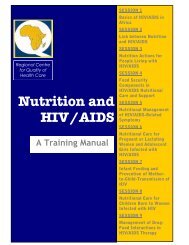2.1: Anthropometric Indicators Measurement Guide - Linkages Project
2.1: Anthropometric Indicators Measurement Guide - Linkages Project
2.1: Anthropometric Indicators Measurement Guide - Linkages Project
You also want an ePaper? Increase the reach of your titles
YUMPU automatically turns print PDFs into web optimized ePapers that Google loves.
P ART<br />
3.Collecting<br />
<strong>Anthropometric</strong> Data<br />
Through Surveys<br />
3.<br />
The type of anthropometric data collected<br />
will depend on the reason for the survey.<br />
When the survey results will be used for<br />
long-term planning the information<br />
needed might be different than information<br />
for program management. The<br />
evaluation of Title II programs is a<br />
situation in which long-term changes in<br />
stunting or undernutrition need to be<br />
reflected. Monitoring of growth promotion<br />
programs will require different types of<br />
information.<br />
The collection of anthropometric data may<br />
be the main purpose of a survey or it may be<br />
part of a larger more comprehensive survey<br />
such as the KPC (Knowledge, Practice,<br />
Coverage). Information on individuals and<br />
households should be collected to interpret<br />
anthropometric data. Deciding what<br />
information will be collected, how it will be<br />
collected and from whom it will be<br />
collected is all part of planning the survey.<br />
The steps that should be taken to conduct a<br />
survey are outlined below.<br />
3.1. Steps for Conducting a Survey<br />
The following checklist outlines the steps<br />
necessary for conducting a survey. All of<br />
these steps should be clearly thought out<br />
before the survey begins.<br />
• Define survey objectives.<br />
The first<br />
step is to determine the specific purpose of<br />
the survey. Make a detailed list of what is<br />
expected to be achieved and what<br />
information is needed.<br />
• Budget for the survey. Develop<br />
a<br />
detailed item-by-item budget for all the<br />
costs and expenses of the survey,<br />
including personnel, supplies, materials,<br />
transportation, accommodation and<br />
meals. Determine the costs associated<br />
with data entry, cleaning, analysis,<br />
reporting and testing of all steps to ensure<br />
smooth implementation.<br />
• Choose the survey design. Depending<br />
on the goal of the survey, the survey<br />
planning team should review different<br />
design possibilities such as a case-control<br />
or reflexive design before choosing the<br />
final design. Having a clear idea of the<br />
survey goals will help to determine which<br />
people or which groups of people to<br />
include in the survey and the best method<br />
for collecting the information.<br />
• Plan for personnel, facilities, and<br />
equipment. Conducting a survey within a<br />
limited time-frame (usually less than six<br />
months) requires early planning for<br />
materials and staff. During this stage the<br />
survey planning team decides how many<br />
field staff and how many office personnel<br />
they will need and how they will recruit<br />
them. Any advance work needed to find<br />
14

















